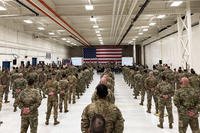Servicemembers and their significant others display great resolve in taking on the challenges of their job, and that quality may need to come into play once they return. The following article by the Substance Abuse and Mental Health Services Administration covers a wide variety of potential challenges veterans and their loved ones might face when it comes time to bring the family back together and settle into a new routine. While there is no guarantee that any one of these situations will arise, knowing the possiblities and learning about them will prepare you if they do.
Servicemembers returning from Iraq and Afghanistan face a number of readjustment factors that may increase the likelihood of needing behavioral health services and coming into contact with the justice system. Deployment also may have an impact on service members' experiences of behavioral health problems and acute stress including:
- Long deployments
- Multiple deployments
- Reduced time between deployments (dwell time)
- High combat exposure
- Family Strife
- Unemployment
- Risk-taking behavior
- Stigma and barriers to care
Long deployments
Among members of Army combat units in Iraq, the length of deployment is a risk factor for behavioral health problems. The risk is highest during the middle months of a soldier's deployment, where the risk of behavioral health problems is highest and unit moral is lowest.
Multiple deployments
Non-commissioned officers in combat units in Iraq were most likely to have served multiple deployments. Non-commissioned officers on their second or third deployment reported higher levels of behavioral health problems or acute stress compared with those on their first deployment. Among non-commissioned officers on their second deployment, the percent reporting acute stress was twice that of those on their first deployment.
Non-commissioned officers in support and sustain units also experienced more behavioral health problems and acute stress with multiple deployments. Non-commissioned officers reporting any psychological problem increased from 7 percent during the first deployment to 15 percent in the second and 17 percent in the third or fourth deployments. For acute stress, the percent increased from 5 for the first deployment to 13 for the second and 15 for the third or fourth deployments.
Reduced dwell time
Dwell time is a term used to describe the amount of time a servicemember has between deployments. Reports of mental health problems among members of Army combat units diminished based on longer dwell time prior to deployment. Servicemembers in combat units with dwell time of at least 30 months reported mental health problems at a rate equal to the pre-deployment rate. However, the median time between deployments was 17 months.
Combat exposure
Increased combat exposure is related to increased acute stress. However, acute stress related to combat exposure could be mitigated or exacerbated by the quality of unit leadership. Individual coping skills also had an impact on resiliency, including maintaining a positive attitude, learning to accept things, maintain a sense of humor, and avoiding self-criticism.
Family strife
Concerns about strife within families start during deployment. Among married veterans of Iraq and Afghanistan referred for a behavioral health evaluation by Veteran's Administration (VA) primary care:
- Four in ten felt like a guest
- One in four felt that their children were not warm or were afraid
- Four in ten were unsure of their family responsibilities
- Three in five disagreed about their family responsibilities
- Three in five felt their relationship was troubled
Most of the veterans who reported concerns experienced them on a weekly basis. A majority also reported problems with domestic abuse.
Unemployment
The unemployment rate among veterans who served in the military since September 2001 is higher than the civilian rate. In 2010, 12 percent of veterans were unemployed compared with nine percent of civilians. The rate is higher for veterans between the ages of 18 and 24 and for veterans who served in the National Guard or Reserves.
Risk-taking behavior
Combat experiences may affect servicemembers' propensity toward risk-taking behaviors following deployment. Experiences such as violent combat exposure were related to feelings of greater self-control, danger-seeking, and impulsiveness. Behaviors such as causing property damage due to anger were related to exposure to human trauma, surviving a close a call, and having killed an enemy combatant or non-combatant.
The risk for the development of alcohol misuse after deployment is most notable for members of the National Guard and Reserves. The likelihood of alcohol misuse and related problems is higher for younger veterans and for members of the Marine Corps. Women veterans returning from deployment are more likely than men to start heavy drinking.
Stigma and barriers to care
Servicemembers who experienced stigma towards behavioral healthcare while deployed reported greater acute stress and associated more stress with combat exposure than servicemembers with low stigma. The most often reported barrier to receiving behavioral healthcare was access. Nearly half of service members in a combat unit and one in three in a sustain and support unit reported that time was not available to obtain services. Twenty-nine percent of service members in a combat unit also reported that it was not possible to get to the location of behavioral health services. One in four reported that unit leadership discouraged the use of behavioral healthcare.
Many of the veterans with mental and/or substance use disorders do not seek behavioral health services. For example,
- One in two Iraq and Afghanistan veterans of all service branches who screened positive for post-traumatic stress disorder or depression sought behavioral health services in the past year.
- One in three Army and Marine Corps combat veterans of Iraq and Afghanistan with mental disorders sought behavioral health services in the past year.
- One in three veterans of Iraq and Afghanistan veterans referred to VA mental health services by a VA practitioner attended an appointment.


















